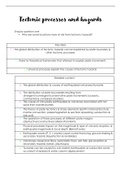Tectonic processes and hazards
Enquiry question one
> Why are some locations more at risk from tectonic hazards?
Key idea
1.1 the global distribution of tectonic hazards can be explained by plate boundary &
other tectonic processes
1.2 there’re theoretical frameworks that attempt to explain plate movements
1.3 physical processes explain the causes of tectonic hazards
Detailed content
a. The global distribution & causes of earthquakes/volcanoes/tsunamis
b. The distribution of plate boundaries resulting from
divergent/convergent/conservative plate movements (oceanic,
continental & combined situations
c. The causes of intra-plate earthquakes & volcanoes associated with hot
spots from mantle plumes
a. The theory of plate tectonics & its key elements (earth’s internal structure,
mantle convection, paleomagnetism & sea floor spreading, subduction &
slab pull)
b. The operation of these processes at different plate margins
(destructive/constructive/collision/transform)
c. Physical processes impact on the magnitude & type of volcanic eruption, &
earthquake magnitude & focal depth (Benioff zone)
a. Earthquake waves (P, S, L waves) cause crustal fracturing, ground shaking &
secondary hazards (liquefaction & landslides)
b. Volcanoes cause lava flows, pyroclastic flows, ash falls, gas eruptions &
secondary hazards (lahars, jökulhaups)
c. Tsunamis can be caused by sub-marine earthquakes at subduction zones
as a result of seabed & water column displacement
,Characteristics of Earth’s layers
Layers Temp Density Composition Physical
state
Crust 400 degree Around Oxygen, solid
(also known as Celsius 2.6g/cm3 silicon,
lithosphere) aluminium,
(thinnest/least iron, calcium,
dense/lightest) sodium,
potassium,
magnesium
Mantle 1000-3700 4.5g/cm3 Oxygen, Mostly
(upper layer of degrees silicon & solid, some
mantle = Celsius magnesium liquid
asthenosphere) (but also iron
aluminium,
calcium,
sodium &
potassium)
Outer core 4500-5500 12.6-13g/cm3 Mostly liquid, Liquid
degrees iron & nickel
Celsius
Inner core 7000 12.2g/cm3 Nickel & iron solid
degrees (primarily)
Celsius
,Plate tectonics theory
Pre 20th century – most Europeans believed a biblical flood played major role
in shaping the Earth’s surface
1912 – continental drift was developed/introduced by Alfred Wegener – he
suggested continents moved & that a supercontinent ‘Pangaea’ once
existed which split apart overtime as the continents looked as if they’d fit
together.
Evidence found later to support Wegener’s theory of continental drift;
- Discovery of mid-oceanic ridges (=an underwater mountain range
formed by plate tectonics. As plates move apart, magma rises along
constructive plate margin, forming new land along boundary of
plates). Ocean floor was newer closer to ridge & found to be older the
further away it was
- Paleomagnetism; evidence of sea floor spreading gained from polarity
of the rocks making up ocean floor. At regular intervals, polarity of
Earth reverses resulting in series of magnetic stripes (North/South) which
suggests the ocean crust is slowly spreading away from the boundary
- They found rocks of same age either side of plate boundary
- Similar fossils were found on different continents (e.g. the plant
Glossopteris) & it was reasoned to be impossible for them to swim
across.
, Plate movement –
Earth’s mantle has temperature gradient – highest temps occur where the
mantle material is in contact with the heat-producing core so there’s a
steady increase of temp with depth.
Convection currents in mantle Slab pull
> Convection is created in mantle à Now considered to be the driving
by heat radiating outwards from force for most plate movement
inner core. The mantle material is
under pressure due to the depth Older/colder plates sink at subduction
& when heated, behaves like a zones because as they cool, they
vicious liquid. Where mantle become denser than the underlying
convection cells make contact mantle, so the sinking plate pulls the rest
with base of crust, they move the of the plate along behind it by its own
plates by frictional drag. weight.
However, if this was the case - plates Oceanic plate is subducted beneath less
with largest surface area would move dense continental plate – density of
fastest as they’d have largest surface oceanic plate pulls it into mantle.
area on which the mantle convection
force would act – but this doesn’t Plates with more of their edges
occur. subducted are the faster moving ones.




